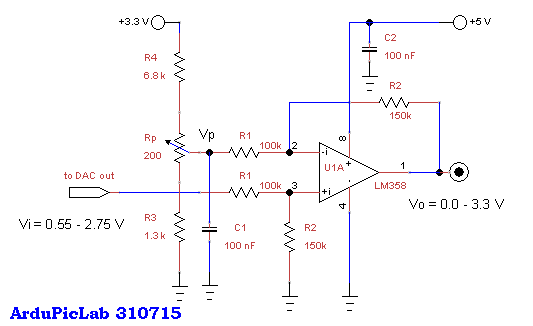How to modify analog output range of Arduino Due
Voltage Translation for Analog to Digital Interface ADC
How to modify analog output range of Arduino Due
Arduino Due does not have an analog output voltage from 0 V to Vref,
but from 1/6 to 5/6 of the reference voltage, that is, 0.55 V and 2.75V with Vref = 3.3 V.
This is also confirmed by the Atmel (see bibliography).
The output voltage range of the DAC is only 2.75-0.55 = 2.2 V, with a resolution of 2.2/4095 = 0.5372 mV.
A simple differential amplifier, realized with an op amp, is used to remove the 0.55 V offset
and to amplify the output signal in order to reach the desired value.
The following figure shows the scheme of this circuit:

To generate the voltage Vp = 0.55 V, that is, the minimum value of the DAC, is used the divider formed by R3, R4 and Rp.
The trimmer pot Rp is used to adjust Vp in order to have an output value close to 0 V in correspondence with the number 0 sent to the DAC.
With a single power supply you can never get exactly 0V but you approach some mV, about 8 in my prototype.
The differential amplifier has the following gain:
G = Vo/(Vi-Vp) = R2 / R1 Vo = R2/R1 * (Vi-Vp)
Just change the gain, for a different output voltage, but less than 4 V,
With a gain G = 3.3 /2.2 = 1.5, the output of this circuit has the desired range from 0 to 3.3V.
It is recommended to use resistors with a tolerance of 1% or less,
particularly for the four resistors of the amplifier.
Don’t use operational amplifier as LM741, LM1458, TL081
and other that are not suitable for single-supply.




【推荐】国内首个AI IDE,深度理解中文开发场景,立即下载体验Trae
【推荐】编程新体验,更懂你的AI,立即体验豆包MarsCode编程助手
【推荐】抖音旗下AI助手豆包,你的智能百科全书,全免费不限次数
【推荐】轻量又高性能的 SSH 工具 IShell:AI 加持,快人一步
· Linux系列:如何用heaptrack跟踪.NET程序的非托管内存泄露
· 开发者必知的日志记录最佳实践
· SQL Server 2025 AI相关能力初探
· Linux系列:如何用 C#调用 C方法造成内存泄露
· AI与.NET技术实操系列(二):开始使用ML.NET
· 被坑几百块钱后,我竟然真的恢复了删除的微信聊天记录!
· 【自荐】一款简洁、开源的在线白板工具 Drawnix
· 没有Manus邀请码?试试免邀请码的MGX或者开源的OpenManus吧
· 园子的第一款AI主题卫衣上架——"HELLO! HOW CAN I ASSIST YOU TODAY
· 无需6万激活码!GitHub神秘组织3小时极速复刻Manus,手把手教你使用OpenManus搭建本
2014-09-14 How to Use a Function or a Procedure as a Parameter in another Function